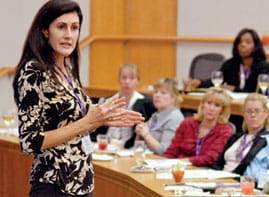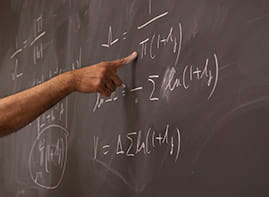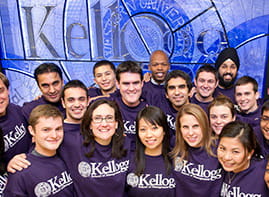1/29/2008 - Today, marketers not only need to mind their P’s and Q’s but their E-I-E-I-O’s too — at least according to Steve Red, president and chief creative officer for Red Tettemer, a creative agency that, among other things, launched the first cell phone marketed exclusively to the “tween” set.
Not to be confused with the refrain of “Old McDonald,” Red’s mnemonic device was the subject of his keynote address Jan. 25 at the Kellogg School’s Marketing Conference. The opening day of the two-day student-led event, now in its eleventh year, occurred at the school's Chicago campus in Wieboldt Hall, drawing nearly 150 participants, mostly corporate professionals who were taking advantage of a conference agenda that blended both theoretical and practical frameworks. Kellogg alumni were also among the attendees.
Red’s talk, titled “A Relentless State of Change,” focused on the transformations taking place in marketing. “It is no longer about what the advertising is doing to the consumer,” he said, “but what the consumer is doing with the advertising.” The message is no longer exclusively outward bound, but has morphed into a two-way conversation between consumers and marketers, Red added. “You have to allow the consumers in because they will participate even if you don’t want them to.”
The staff at Philadelphia-based Red Tettemer use E-I-E-I-O as their guideline for how to make that conversation a beneficial one, both within and outside of the firm:
* E (for ear) encourages marketers to listen to “find and identify signals that can inform how you develop your marketing message,” noted Red.
* I (for innovate) stands for the company’s environment of systematic innovation: “You have to develop a way of thinking that is constantly pushing you forward, and create an environment where people feel safe to take risks.”
* Engage and Interrupt drive marketers ahead of their competition. In today’s world, engage or be TiVoed, Red joked. “Do work that’s so unique that it can’t be attributed to anything but your brand.”
* O (for open) reminds Red’s team to keep an open mind and imagination. “Open yourself to a permanent state of change,” he advised.
Each of these points is increasingly important when navigating the contemporary digital space, a point that linked directly with a practicum session led by Michael Marquis, consumer product director at Johnson & Johnson. Marquis shared examples with conference attendees of how the company has interacted with new media while continuing to include some classical marketing in its strategic portfolio.
The formula that has worked for him is what he called “70-20-10:” spending 70 percent of media dollars on what works, such as TV commercials; 20 percent on a related media vehicle, such as video on demand; and 10 percent on the newest trends, like the Johnson did with YouTube for its Clean & Clear products. This marketing strategy helps prevent what Marquis called techno-ecstasy. “Don’t change your mission as you move into the digital world,” Marquis cautioned. “Choose vehicles that fit with your brand.”
These presentations were anchored with two one-hour lectures by Kellogg School professors. Called MBA Updates, these talks presented the conference participants with strategies and research from the classroom that could be implemented immediately in their companies. The lecture by Mechthild Esser Nemmers Professor of Marketing
Angela Y. Lee was titled “Rethinking Message Strategies,” while Professor of Marketing
Anne T. Coughlan presented “Aligning Channel Partners for Effective Go-to-Market Strategies.” Both presentations mimicked a classroom setting and complemented the other speakers. A question and answer session followed each of the four sessions.
Sandra Rodriguez ’97 (EMP-36) attended the conference’s first day. She found it to be a “value-added” experience that has been helpful to her since she is in the midst of creating her Web-based startup. “As I am developing new products, it leads me to ask the right questions and it has been a tremendous networking opportunity.”
Though the Marketing Conference is in its eleventh year, the Friday portion of the event is relatively new. According to Tamsyn Smith '08, a conference co-chair, the first day's agenda "emerged in response to feedback received from attendees that indicated they would like to have an opportunity to hear from Kellogg professors on current topics affecting marketers today."
Smith was among the student leaders responsible for creating a program that offered corporate attendees and alumni "an opportunity to return to an MBA setting and participate in interactive discussions on issues they may be facing day to day in their firms."
The second day of this year’s
Marketing Conference was held Jan. 26 at the Donald P. Jacobs Center in Evanston. It featured a range of panel discussions, keynote addresses and networking opportunities.






